R&D managers are expected to excel in various roles by leveraging their individual expertise. They are tasked with creating an environment that allows researchers to concentrate on their work. In addition to planning and managing research projects and promoting the utilization of research findings, they are also expected to contribute to social implementation and take on increasingly diverse and complex challenges. As the need for R&D management personnel, who play a dual role as researchers, is increasing at universities and research institutions, JST News investigated their current status and future prospects. As part of this, they spoke to Dr. Keiichirou Yonezawa, Research Strategy University Research Administrator (URA), Deputy Director, Kyushu Institute of Technology, and Akiko Takami, Director, Human Resources Policy Promotion Office, Human Resources Policy Division, Science and Technology Policy Bureau, Ministry of Education, Culture, Sports, Science and Technology (MEXT).
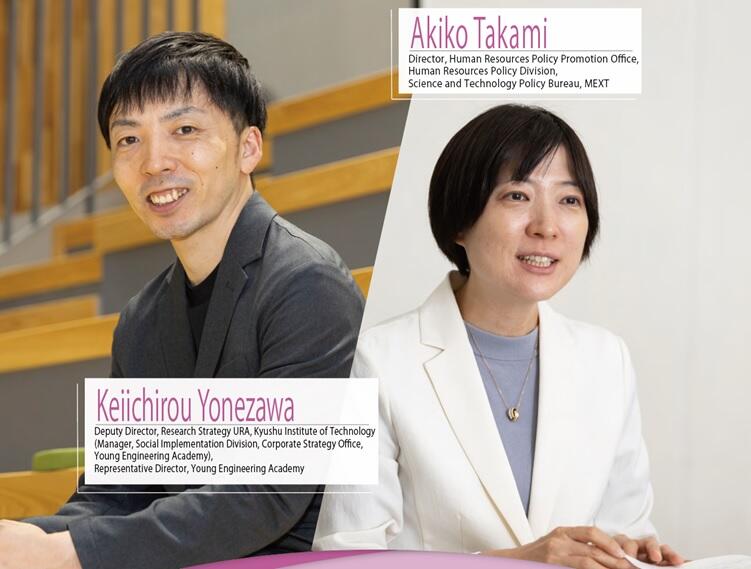
The state of R&D management personnel: Discussion of future prospects at MEXT
In December 2023, MEXT established a working group (WG) to study the duties, issues, and future prospects of R&D management personnel, including URAs. This was established under the Human Resources Committee of the Council for Science, Technology and Innovation. "The WG was set up because we needed to understand the situation around URAs and other R&D management personnel. The aim is to strengthen research capabilities and create innovation. It will also help us to consider future measures," said Takami.
R&D management personnel are not just URAs. They can be faculty members, researchers, administrative staff, professionals in various positions, and other personnel engaged in R&D at universities and research institutions. MEXT has been developing measures related to the training and recruitment of URAs for about 10 years. In 2013, skill standards for URAs were created, along with training and education programs. Progress has been made in developing content for training URAs. At the same time, progress has been made in the placement of URAs at universities. This has been achieved through projects to develop systems for training and recruiting URAs. Initiatives to promote the strengthening of research universities are also involved.
To improve the quality of URAs, an accreditation scheme and training curriculum for URAs has been developed. The scheme has been running since 2019. Takami recalls, "Against the backdrop of these initiatives, the number of assigned URAs has increased. The figures went from 300 at the beginning of Fiscal Year (FY) 2013 to 1,600 in FY 2021." Note: A simple comparison of the number of URAs is not appropriate. This is because URAs and industry-government-academia collaboration coordinators, which had been recorded separately earlier, are now recorded together.
Nevertheless, many universities still find it difficult to secure human resources when hiring new employees. This suggests that the university management needs to improve their recognition of URAs. In their current situation, tenured posts are limited, and it is difficult to establish a career path. On the contrary, some universities prioritize URAs and help them function effectively. For example, URAs may be empowered to participate in university management. It is essential to publicize such cases. Large-scale programs operating within government-run R&D projects are continuing to expand. Therefore, universities are increasingly in need of human resources that can create value and contribute proactively. Stable, ongoing development of such human resources is thus a highly significant task.
JST's endeavors to develop and promote human resources
The Japan Science and Technology Agency (JST) is also working to promote and develop R&D management personnel. Among these initiatives is the Program Manager Development and Promotion Program (PM training). The PM training has been running since 2015. Its aim is to strengthen open innovation among industry, academia, and government. This involves increasing the ability to generate innovative technology seeds. The program also strengthens the bridges linking these technology seeds to rapid commercialization by private companies.
The PM training consists of two stages. In the first stage, approximately 20 trainees selected from the public learn basic skills and knowledge. They then conceptualize R&D programs with the advice of mentors. In the second stage, trainees who pass the screening process conduct a feasibility study to deepen the concept (Figure 1).
Figure 1:PM Development and Promotion Program (PM training)
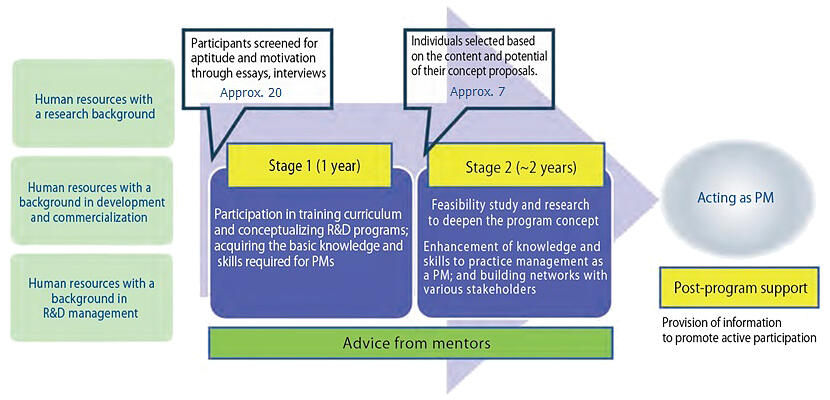
Keiichirou Yonezawa, Research Strategy URA and Deputy Director, is serving as a R&D management personnel at Kyushu Institute of Technology and is a graduate of the PM training. In April 2024, at the age of 37 and in his eighth year of employment at Kyushu Institute of Technology, he was appointed a Deputy Director. He is in charge of the Social Implementation Division, Corporate Strategy Office, and also serves as the Representative Director of the Young Engineering Academy. Yonezawa participated in the PM training in 2018, during his second year at Kyushu Institute of Technology as a URA. "I had been in research for a long time, but I didn't have sufficient skills or knowledge, so I decided to apply for the PM training. I was also attracted by the program content, which involved thinking out an R&D program for myself."
Yonezawa progressed to the second stage of PM training, but achieving it was not easy. At the interim report meeting for the first stage, his R&D program was harshly criticized by several Expert Committee members. After that, it took six months of frequent visits to them to gain their approval. "This experience taught me how to present concepts in an appealing way," he said. "I also realized the importance of matching the needs of society with the projects that researchers want to do, which is the starting point." These learning points still inform his current work. Other than Yonezawa, the PM training has produced many graduates who are active as R&D management personnel (Figure 2).
Figure 2:Activities of PM training alumni
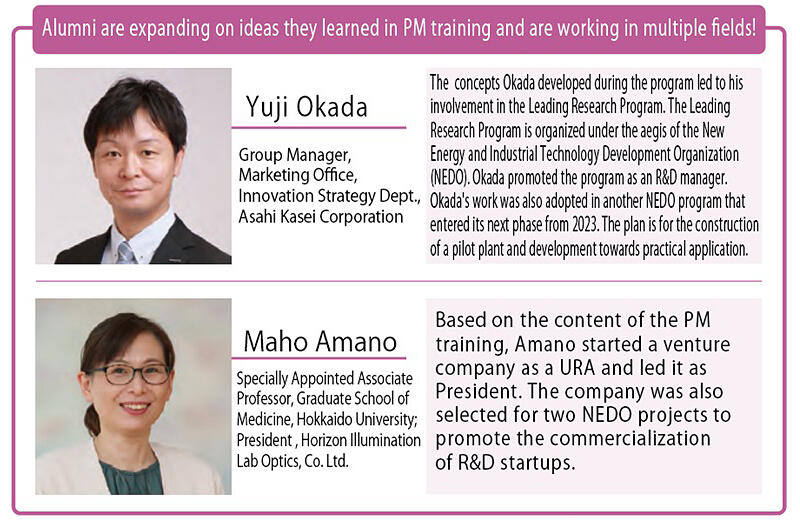
Thoughts as a research strategy URA: Connecting researchers' intellectual curiosity and policy
Yonezawa received his Ph.D. from Chiba University. His specialty was the condensed-matter physics of organic semiconductors. After graduation, he worked for one year as a Japan Society for the Promotion of Science Research Fellow PD at the Institute for Molecular Science. During his graduate school years, he aspired to pursue a career contributing to the university as a supporter for researchers. When he was a senior undergraduate student, he was told by his advisor, "Universities are places to create technology and human resources that will support the future. If we can empower such places, we can energize the country." At the same time, he saw in himself an aptitude for servant leadership. He earned a doctoral degree to share the same perspective as the researchers he supports.
"If you don't understand the hardships and joys of being a researcher, you don't share their values," Yonezawa said. "Although I wanted to contribute to the university, I thought it would be difficult to work alongside researchers in the same position." He heard about the URA position from a researcher he met for the first time at a reception. This happened while he was at the Institute for Molecular Science. His main job title has remained the same since he joined Kyushu Institute of Technology at the age of 29: Research Strategy URA. Research strategy URAs are responsible for developing their own hypotheses as R&D management personnel and creating concepts for R&D programs.
"Academic research is an activity arising from intellectual curiosity," Yonezawa added. "It is not something that is forced upon us by others." Conversely, lack of resources, such as budgets and human resources, may prevent researchers from engaging in exploratory activities as much as they would like. "We will remove those restrictions and allow researchers to engage in exploratory activities as their curiosity leads them. That is also my mission," he added. Therefore, Yonezawa is focused on providing support services for competitive funding applications. "We work hard to connect with policy objectives, conceptualize, and enhance the appeal of content that can be evaluated by donors to obtain funding. At the same time, we try to understand the day-to-day concerns of researchers."
Serving as a research strategy URA: Realizing visions in two programs
One of the outcomes that Yonezawa is pursuing as a research strategy URA is to create an innovative university that promotes the social implementation of academic seeds. This can be achieved by taking advantage of Kyushu Institute of Technology's strengths in social implementation. First, in April 2023, Kyushu Institute of Technology was selected for the Program for Promoting the Enhancement of Research Universities with Regional Core and Distinctive Characteristics. This program will assist in the development of the Institute's tangible infrastructure. The "Kyushu Institute of Technology Mirai Terrace" is currently under construction at the Tobata Campus, with completion scheduled within FY 2024. The budget for developing the facility is approximately 1 billion yen. This facility will be a center for strategic staff who will be responsible for the realization of ideas generated in academia. They will also cover social verification of research findings and the development of necessary regulations.
Additionally, the campus has a facility called "GYMLABO," which was built to promote interaction among stakeholders when promoting industry-government-academia projects. Yonezawa serves as its director (Figure 3). Based on the organic collaboration between these two facilities, the Institute is currently applying to be selected for the "Program for Forming Japan's Peak Research Universities (J-PEAKS)." The aim is to further enhance the Institute's level of social implementation based on its strengths and distinctive characteristics. This will involve building tangible and intangible environments necessary for the international expansion of research activities.
Figure 3:GYMLABO, a forum for active exchange to promote industry-government-academia projects
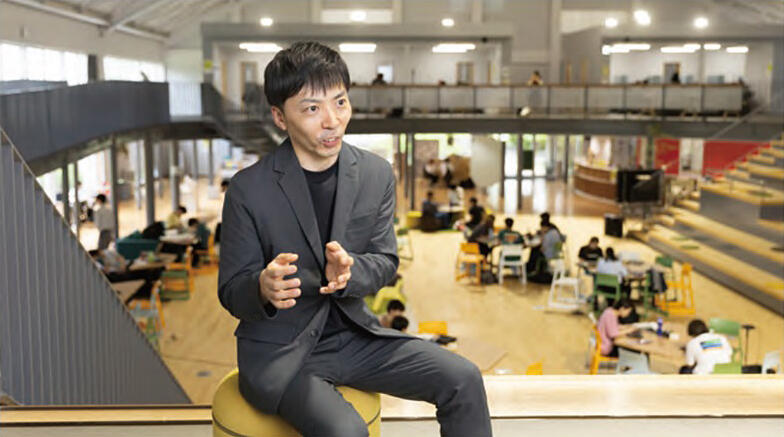
Kyushu Institute of Technology has also been selected for the "Startup Ecosystem Co-creation Program for the New Industry Creation Fund for University Startups," which is operated by JST. The goal of this project is to create an ecosystem in which human resources, knowledge, and funds circulate to support the continuous creation of university-launched startups. Kyushu Institute of Technology is the leading institution, along with Kyushu University. The Institute has proposed a platform called "PARKS (Platform for All Regions of Kyushu & Okinawa for Startup-ecosystem)." The platform will be built by 18 universities and one private company in Kyushu and Okinawa (Figure 4).
Figure 4:Objectives of PARKS
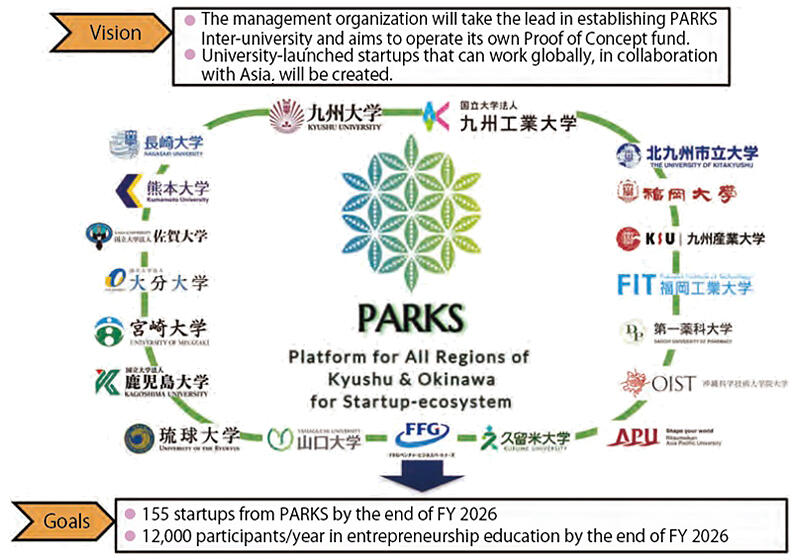
"The subsidies provided for platform operation are one billion yen. We have already started activities for creating startups." It is hoped that the development of the Institute's intangible environment will be approved as a J-PEAKS project. Upon approval, the plan is to hire postdoctoral researchers and students who will be responsible for materialization of ideas and social implementation of research results. Two R&D programs will strongly support the realization of Kyushu Institute of Technology's vision of its future as a university of innovation. Kyushu Institute of Technology has five research strategy URAs, including Yonezawa. The Institute has made significant strides toward realizing its vision for the future. This is because it has retained talented individuals who are responsible for creating concepts for R&D programs. Yonezawa acknowledges that his role is to contribute to the Institute's management to maximize this value. Thanks to his appointment as Deputy Director, he is now working more closely with the Institute's management.
Representative Director of the Young Engineering Academy, Yonezawa attends the Institute's Management Council as an observer, along with 11 other executive secretaries. The Management Council deliberates on important matters related to the running of the Institute. "The Institute has formulated a 'ten-year vision' proposing to be a university that drives social change with integrative knowledge. During the formulation process, management asked for my input, and much of it was adopted. URAs are also involved in university management as Deputy Directors, regardless of their age. My own career has clearly demonstrated this possibility," Yonezawa asserts.
Efforts are underway to further enhance R&D management personnel
Government-subsidized training and certification was conducted by the Japan Certification Board for Research Administration and Management Skills. In 2024, the training was transferred to JST. The URA training consists of two levels. The Fundamental level is designed to provide basic knowledge to people with a little or no experience as a URA. Trainees include inexperienced URAs, university administrative staff, working adults, and graduate students. The Core level is intended for individuals who have several years of experience as a URA, and for those who understand the content of the Fundamental Level (Figure 5). The training is online and video based. making it easy to take the course.
Figure 5:Outline of URA training to be conducted at JST from 2024
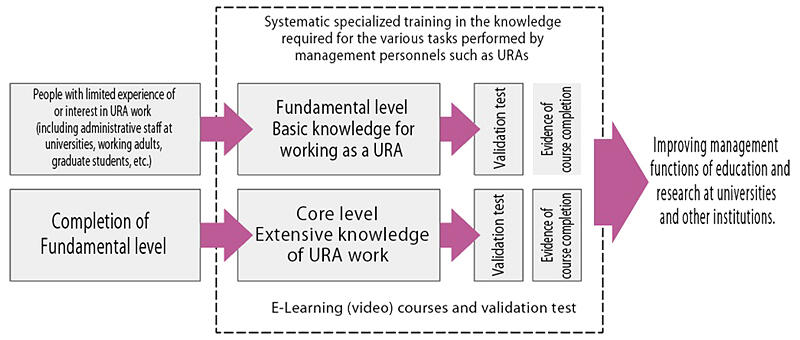
With the transfer of URA training to JST, training will be provided free from FY 2024. This project is expected to attract interest from more people, including university administrative staff, and expand the base of R&D management personnel. In addition, JST promotes integrated operation and promotion of URA and PM training (Figure 6).
Figure 6:Integrated operation and promotion of URA and PM training
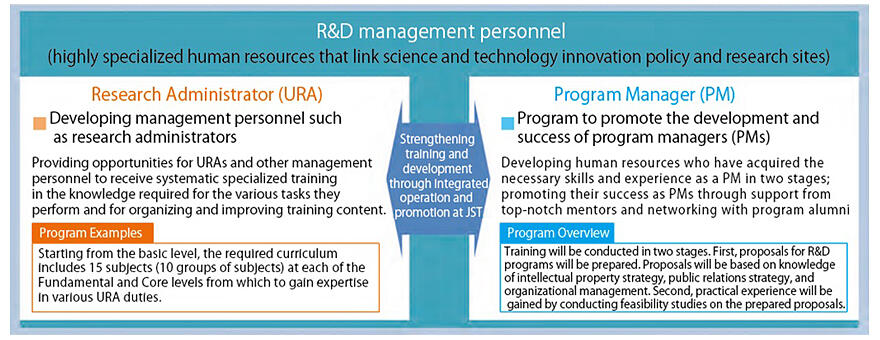
In FY 2023, JST established a personnel system to recruit and train R&D management personnel (R&D management specialists) as a new professional category. This is an ambitious initiative. JST will not only provide training as it has in the past, but also hire and train its own employees over the long term. This system also emphasizes the mobility of human resources. Career skills developed at JST can be utilized in R&D throughout Japan.
The need for R&D management personnel who can collaborate with researchers to improve research capabilities and create innovations is also increasing. These specialists are expected to play an active role in various fields, including large-scale national projects. Going forward, we will continue to closely cover Yonezawa and other R&D management personnel.
(Text: Shunsuke Moteki; photos: Hideki Ishihara)




